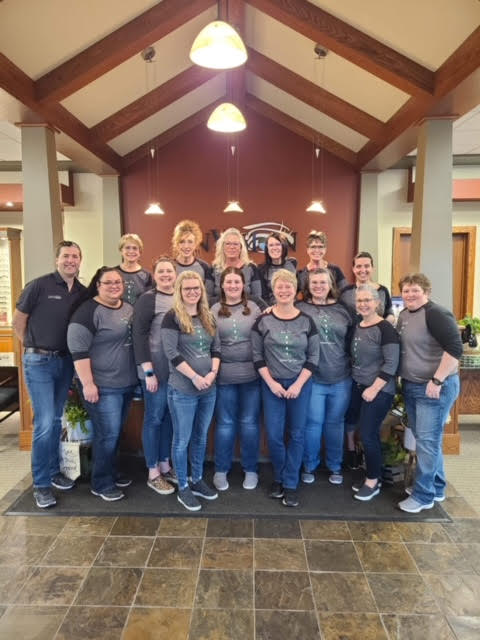
Dr. Kempfer (back row, second from right) with her practice team. She says that learning how to communicate effectively to one another, and to patients, is a key to delivering a high level of care and a great patient experience.
By Tara A. Kempfer, OD
Feb. 8, 2023
Communication skills can make or break a practice. Your employees need to understand one another, and then communicate a unified message to patients. A practice with team members unable to effectively communicate will never have a staff that’s on the same page to achieve shared goals while providing a high level of care.
Here are our communication challenges and the training resources that changed my practice for the better.
Identify Your Greatest Staff Communication Challenges
Being comfortable with difficult conversations, such as speaking with a co-worker, or manager, whom an employee does not feel aligned with, is a top communication challenge in most workplaces, including practices. These difficult communications are often required between colleagues, between support staff and doctors and between doctors/staff and patients.
Resources that Changed How Well We Communicate
We use numerous training resources, as communication training is as ongoing process that never truly comes to an end.
Your Local Community College
Recently, our entire staff utilized a workforce development solutions program through our local community college. We hosted the hands-on, interactive courses at our clinic during our scheduled monthly/weekly staff meetings. Staff development and training is often an area for which your state will provide grants to cover your training costs.
Be creative and reach out to your local economic development center/group, local colleges and access your state’s employment and economic development agency. Our staff and ODs completed the college’s Strength Based Leadership five-hour course and its course on Building and Maintaining Trust Through Communication and Conflict.
Think GREAT
Another great resource for us: Think GREAT, training programs created by Erik Therwanger. This resource has provided amazing training options for our staff and ODs. The program provides abundant methods for training depending on your specific needs. For example, we applied the Think Great; Leadership Connection Program for developing our “leads” staff. The program was interactive, provided workshop options and was accompanied by workbooks/materials, as well as online access to forums and FAQ. In addition, we used the Think Great; Communication Movement training for our Patient Care Representatives. It provided a dynamic resource to teach communication skills to unify our staff and create cohesion.
American Optometric Association (AOA) Resources
AOA education has excellent means to access training and communication skill enhancement for your clinical staff, and is provided at no cost with membership. EyeLearn is a professional development hub that provides access to online courses and quizzes. They are topic-specific and easily accessible within the EyeLearn online catalog. As our staff completes a topic of interest to them, they turn in their course information and we put them into a drawing for a prize. So, it’s a win-win for all of us! AOA certification related to the following certifications include communication training opportunities: CPO, CPOA, CPOT and CPOC.
The Ritz-Carlton Leadership Center
We completed training, which included segments on communication training, via The Ritz-Carlton Leadership Center years ago. There are virtual keynote presentations to watch, virtual live webinar options and interactive workshop experiences.
Other Articles to Explore
Disney Institute
Both online and onsite options are available through the Disney Institute. Among other lessons, staff will learn how to communicate effectively with each other to deliver a high level of service, knowing what to keep “back stage” and what belongs “front stage.” They also will learn how to communicate with customers (in our case, patients) to ensure they have a “magical” experience.
Crucial Conversations
This program, Crucial Conversations, by Joseph Grenny, taught us how to better navigate daily interactions in the office.
Learning to discover, “What is the right conversation?”: Realizing and addressing our own motives; what do I really want for myself, for others involved and for the organization? This approach gives us insight when dealing with tough conversations. It holds us each accountable to be sure we are engaged and have the proper mindset when in a conversation. We have learned to “watch our ques” in order to recognize when we are going to get distracted in a conversation.
How we communicate under stress: We are now aware if we tend to “lean toward silence” (masking, avoiding, withdrawing) or “violence” (controlling, labeling, attacking). Being aware of coping skills and how to avoid the negative channels has been a great tool for our clinic communication success.
Listen: Be sincere, get curious (get to the source), stay curious, be patient.
The more listening you do, the less talking you need to do: Data shows that patient satisfaction isn’t tied to how much time you spend, but related to how you interact with patients during that time. Listen first. Speak last. Time is the new money. We want the patient to view their experience as time well spent. Patients are expecting to be engaged in meaningful care. More time that is well spent provides a greater value for you and your patients.
When we disagree, we can now employ the following strategy:
- Start with areas of agreement no matter how small.
- Build when others leave out key pieces (I agree completely, in addition…).
- Compare areas of disagreement (I think I see it differently, let me explain how).
Tricks of the Communication Trade
All of this training enabled us to identify solutions to avoid miscommunications, and resolve them, when they happen:
- Determining the source of a disagreement; and how to get to “communication” before “conflict.”
- Training new staff consistently so they are all hearing the same message and presenting the same message every single time to each other and patients.
- Ensuring our part-time staff are clearly informed about expectations and policy changes that occur when they are not onsite every day.
- Perceiving and understanding constructive criticism; both giving and taking.
Create Checks for Your Practice to Ensure You Are Communicating Well–Even After Patient Visits
Systems we have in place to ensure communication is smooth and consistent would include a “call list” that is checked daily. These patients are called based on follow-up needs that the doctor has requested. It can be done on paper or within the EHR as a “task.” It is an effective and simple way to follow-up and ensure the patient has the ability to verbally ask questions.
The follow-up communication also enables our staff to confirm that the patient is being compliant with treatment plans. A proactive “reach out” can prevent a conflict, confusion or anger from patients. This additional communication does not occur with every patient, but at the request of the OD.
We also schedule a check-in message with every patient receiving eyewear from our practice. Phone calls or a text message occurs two weeks after the dispensing of their eyewear to make sure expectations are met and resolve any issues the patient may be having. We want everyone to LOVE their new glasses!
We want to give our patients every opportunity to be heard by us, and to have us provide just the information they need to most benefit from our services.
 Tara A. Kempfer, OD, is the owner of InVision Eye Care in Fergus Falls, Minn, which was named one of CooperVision’s Best Practices. To contact her: tak@ffvision.com
Tara A. Kempfer, OD, is the owner of InVision Eye Care in Fergus Falls, Minn, which was named one of CooperVision’s Best Practices. To contact her: tak@ffvision.com

























